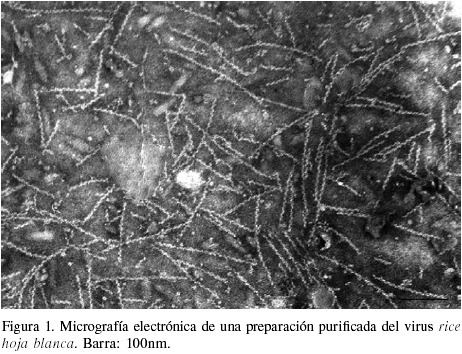Group Group V ((−)ssRNA) Family Unassigned Scientific name Rice hoja blanca virus Rank Species | Order Unassigned Genus Tenuivirus Higher classification Tenuivirus | |
 | ||
Similar Tenuivirus, Rice stripe virus, Rice grassy stunt virus, Rice dwarf virus, Delphacidae | ||
Rice hoja blanca virus (RHBV) is the agent of the most important viral disease of rice in Latin America. The disease is found in Mexico, throughout Central America and the Caribbean region. In South America the disease is endemic to Colombia, Venezuela, Ecuador, Peru, Suriname, French Guiana and Guyana.
Contents
Symptoms
The symptoms in rice are chlorotic streaks that can coalesce and cause the leaves to turn white. When young plants become infected, they are stunted and in severe cases the leaves turn necrotic and the plants die. Infections that occur before the emergence of the panicle can reduce seed set and quality. RHBV epidemics are cyclic. During the peak of RHBV epidemics, yield losses at the country level have been estimated to be between 25% and 50%.
Biology
Rice hoja blanca virus is a member of the genus Tenuivirus. The RHBV genome consists of four single stranded linear RNA species, and the total genome is estimated to be 17.6 kb The RNA 1 is 9.8 kb and encodes for an RNA dependent RNA polymerase on the negative strand. The RNA 2 is 3,620 nucleotides and encodes two proteins using the ambisense coding strategy. The RNA 3 consists of 2,299 nucleotides and encodes for two proteins using an ambisense coding strategy. The nucleoprotein gene (N) is encoded by the virus complementary strand of RNA 3. The RNA 4 consists of 1,991 nucleotides and encodes for two proteins using an ambisense coding strategy.
Vector
The planthopper Tagosodes orizicolus (Muir) is both a host and vector of RHBV. The virus is acquired through feeding on an infected plant, and there is a period of 17–22 days of viral propagation before the planthopper becomes viruliferous. There is a high rate of transovarian transmission to the progeny, and these nymphs can transmit the virus shortly after they emerge.
